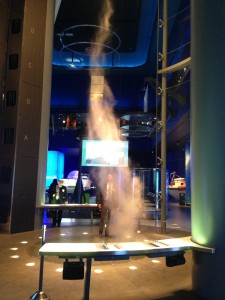30th May 2013 Chicago, USA
Big Science, Big Challenges
Big Science is expensive, and as justifying why tax dollars should pay for large scientific instruments is more difficult than ever. But Big Science is important and in these times of austerity, researchers and science leaders must do a better job of explaining how large scientific endeavours such as particle accelerators, massive light sources or the human genome project contribute to a nation’s prosperity.
I recently attended a reception hosted at the Museum of Science and Industry, where the directors of the University of Chicago, Argonne National Laboratory, and Fermi National Accelerator Laboratory addressed these challenges head on. Argonne and Fermilab, both managed by University of Chicago, were born out of a desire to do Big Science – the Manhattan project (arguably the biggest ever science project) at Argonne, and particle acceleration at Fermi. Big Science still thrives at these labs today due to their commitment to big thinking, team research and collaboration. To me, the opportunity to build large, multi-disciplinary teams to solve big problems is one of the most exciting things about Big Science.
However, to continue to justify Big Science in the public arena, researchers must amplify the contribution of their research, however basic, to society. For instance, research conducted at particle accelerators has underpinned current cancer treatments and will continue to inform medical treatments of the future as well as establishing the basic theory behind newer, safer, nuclear reactors. Big Science solves big problems and we must do a better job of framing projects such as the Large Hadron Collider and hunt for the Higgs’ Boson in relevant, digestible context for the public.
I came across the website Scienceogram.org, which does a great job of contextualising UK science funding in terms that are easily understandable for everyone – for instance, did you know that that cancer research in the UK costs just £5 per taxpayer per year, whilst the hunt for the Higgs costs a paltry £1.50! Breaking funding down in these relatable terms emphasises the relative efficiency of Big Science, but more can be done in putting the outcomes in perspective to demonstrate how investment in Big (and small) Science results in a more prosperous society.
Big Science often needs big machines, and no one country alone can currently afford to make massive investments required to build, for instance, a $9bn Large Hadron Collider. The LHC, a result of the collaborative efforts of over 10,000 scientists in 109 countries, is an astounding example of how international collaboration facilitates groundbreaking scientific discovery whilst delivering value to the governments and organisations that fund these projects.

Back at the Museum of Science & Industry, Eric Isaacs (Director, Argonne), Piermaria Oddone (Director, Fermilab) and Bob Zimmer (President, University of Chicago) were each asked what areas of science they were most excited about for the future. Tellingly, the same topic was at the crux of each answer: computation. Be it materials science, nuclear fusion or genome analysis, Big Science creates Big Data – and the capacity to understand and analyse this data limits our progress. This is great news for the UK, which is home to some of the world’s leading experts in computation, theory and simulation. Combined with the computational infrastructure, and big equipment at the US National Labs and other organisations, the UK and US possess the tools necessary to address the Big Science problems of the future. The UK has also recognised the importance of computation with an investment of £189m into energy efficient computing and big data processing as part of the 8 Great Technologies initiative and reflects the fact that big data looms large in each of the other 7 technologies.
This Cancer Research UK advert so succinctly and powerfully states, the more science we work on, the quicker we will solve the world’s grand challenges. Big Science faces big challenges, not least in maintaining funding. The reception at the Museum of Science and Industry underlined how science is at the heart of economic growth, but to continue to gain the funding required to tackle big problems, researchers must better communicate to the public the huge impacts this research has on their daily lives and on a nation’s prosperity. Chicago is a city with a long history of thinking big. Architect Daniel Burnham, in designing the buildings of the 1893 World’s Fair said “Make no little plans, for they have no magic to stir men’s blood”. If researchers continue to evoke the spirit of Burnham with inspirational vision AND justify the money spent in terms of public good, I have no doubt that Big Science will continue to solve big problems for generations to come.